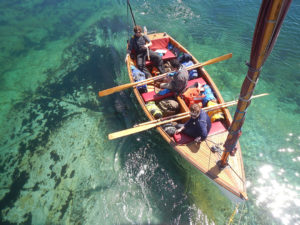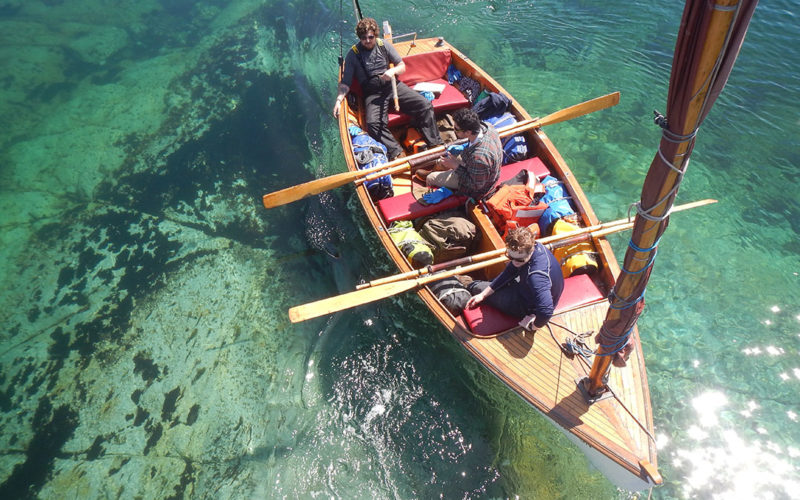
You learn to ride a bike by falling. You learn to swim by not drowning. A sailor learns to sail by sailing. And it helps if they sweat at it.
This is the idea behind the Summer Mariner Program at Coastal Transportation Inc. (CTI). As the last U.S. fleet operating “stick ships,” Coastal’s refrigerated freighters travel the Inside Passage of British Columbia, across the legendarily nasty Gulf of Alaska, to service the remote ports of the Alaskan Peninsula and Aleutian Islands. It is a challenge for even experienced mariners, one requiring precise navigation, long hours and dirty hands. For academy students on their first commercial voyage, it is a dive into the deep end of seamanship.
Crash course in seafaring
The typical maritime academy internship places the student on a commercial boat, observing pros working on deck and in the wheelhouse — maybe with a little participation in the less technical aspects of the work. Coastal’s Summer Mariner Program is radically different. The interns work as actual paid deck hands. To prepare them for a summer of seafaring, CTI provides a paid crash course in the gritty world of nautical life. At CTI’s Seattle terminal, experienced crewmembers tutor the trainees in operating yard-and-stay gear, driving lift trucks and lashing down cargo.
To top all of this off, the trainees board the company’s training boat, Curlew, for a special expedition through the Salish Sea. The trainees (usually a group of three) start engines, handle lines and clean heads, all under the watchful eyes of CTI officers. The trainees pilot the boat with compass, paper charts and radar — no plotters or GPS allowed.
This steep learning curve of useful seamanship gets steeper. At the north end of the Salish Sea lies Desolation Sound, the jumping-off point to sparsely populated northern British Columbia. Here the trainees leave the steel-hulled Curlew and board Oyster, a wooden 17-foot-long open boat. No motor, no deck. The next leg of the journey, through a maze of waterways, saltwater rapids and islands, will be done entirely under oars and sail.
What the heck am I doing here?
Row harder. Oyster, packed with its crew of four, is ambling along under two pairs of oars. This morning the boat cuts through turquoise waters as smooth as glass, surrounded by immense fir trees and granite shores.
But you screwed up. Yesterday, the skipper gave you the job of planning the route and estimating the time of slack in Johnstone Strait’s Current Pass. You got sloppy and failed to triple-check your figures.
Without warning, upwellings of current break the mirror-smooth water, like bubbles in a boiling cauldron. The shoreline stops gliding past. The boat becomes a cork in a maelstrom. The flood tide, rushing down from Queen Charlotte Strait like an unseen freight train, has arrived, and your stupidity has placed your crew in front of it.
You need to salvage things quickly. Get your crew to safety or be swept down channel by the 5-knot current, or worse yet, be driven up on dangerous Ripple Shoal.
The danger is palpable. The oars bend alarmingly as your crew rows hard for a tiny cove with a back eddy. Here, on Helmcken Island, your crew catches its breath and nurses blistered hands. A close call. Lessons learned: Triple-check your figures; never underestimate the power of a tide; and always keep in mind the safety of your crew.
The Oyster expedition — five days and 120 miles of rain, swiftly changing currents and adverse winds — is the most intense seafaring experience an academy student will face. Oyster’s skipper, a veteran CTI navigator, allows his trainees plenty of rope to get into trouble, but not quite enough to hang themselves. Rowing by day and camping ashore by night, they toughen up and develop a sense of responsibility while losing any illusions of competency they may harbor.
In a few days the crew will rejoin Curlew in Queen Charlotte Strait and steam back to Seattle, where the trainees will board freighters bound for the Aleutian Islands. When they do, it will be as useful deck hands, with palms already callused. Later, after graduation, these same trainees might sign on with the company as watch officers and navigate their ship through these same treacherous waters, with the important lessons of navigation and responsibility already learned. •
Capt. George Collazo is a port captain with Coastal Transportation Inc. of Seattle. He is an alumnus of the California State University Maritime Academy.

